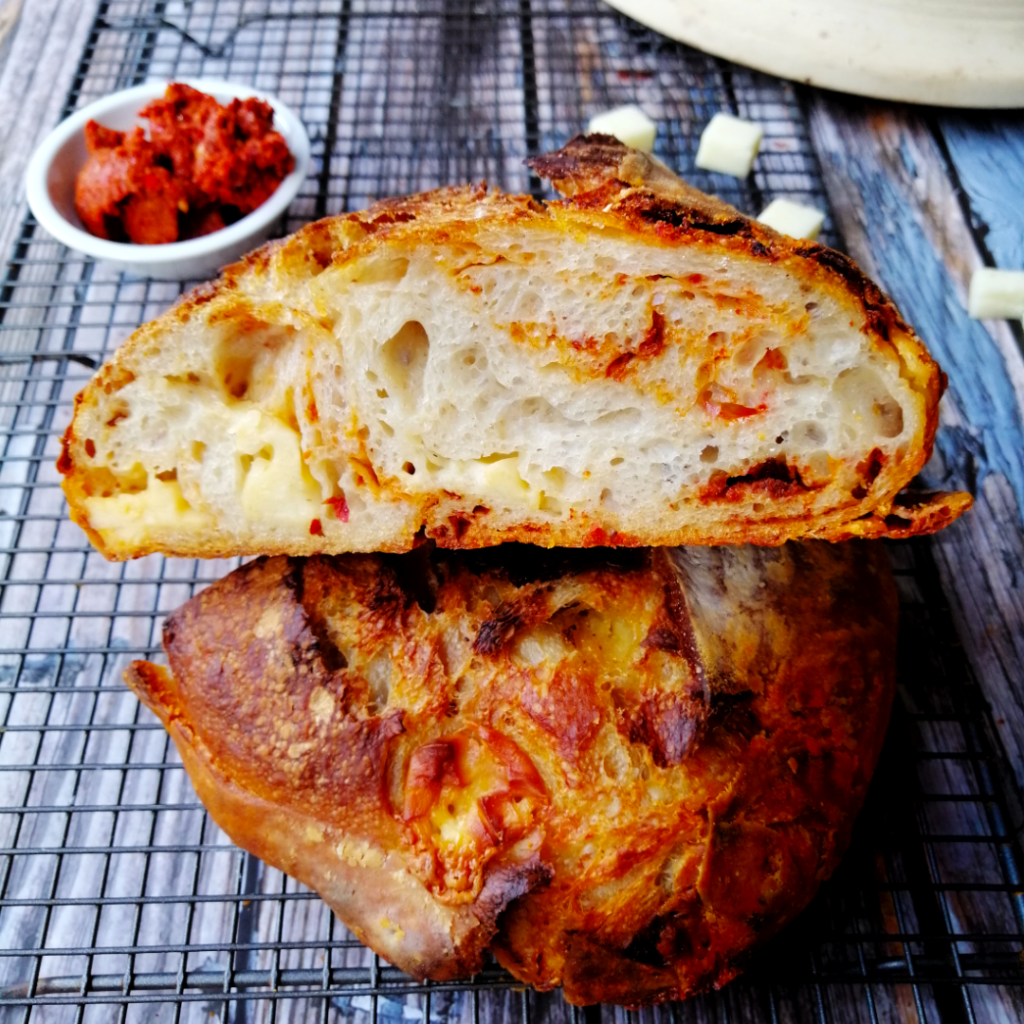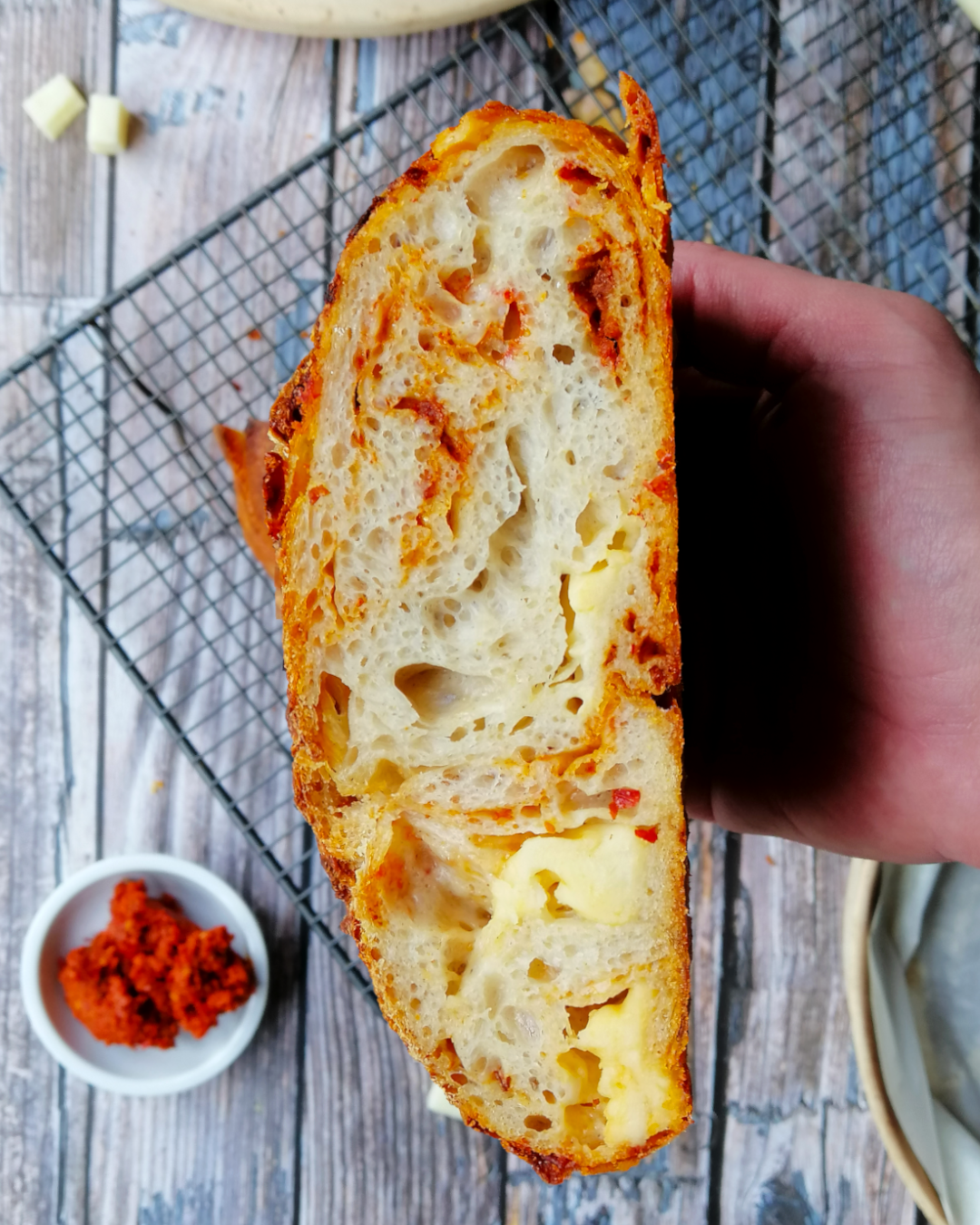In partnership with Vico Food Box, Italian food at low prices with free shipping throughout Europe
There are few things better than a slice of freshly baked homemade stuffed bread. This ‘nduja and provolone sourdough bread combines the best of the worlds I live in: hearty sourdough bread from Britain and some of the most amazing ingredients from Italy, giving you the most delightful stuffed loaf.
Brits love their bread and Britain has a long baking tradition, going back centuries. Something I realised in recent years is that Brits actually love stuffed and flavoured bread. I guess is a different way of enjoying a “panino”.
In Italy, bread is mainly baked and offered ‘plain’, to be eaten alongside meals or to be sliced and filled with all sorts of salumi (charcuterie), cheese and veg, to make the most delicious panini(s).
But why to not combine the two ideas in a delicious and shareable rustic savoury treat packed with flavour? So, I did.
For my first ever proper stuffed bread, I chose sourdough bread. I chose it because it’s particularly suitable for this kind of baking process, thanks to its tangy and deep flavour, rustic texture and for the (generally) medium/large size of the loaves.
For the fillings, I chose two Italian delicatessen, which in recent years have become super popular pizza toppings in London: ‘Nduja sausage and sweet Provolone cheese. Hot and spicy spreadable meat from Calabria and sweet and nutty cheese originated in Naples, a match made in heaven.
Using only the best ingredients (authentic and top-quality) is of course a must when making a proper stuffed bread – and any baking goods in general. For this recipe I got my ‘nduja and provolone from the guys at Vico food box. They offer a huge selection of high-quality local products they source throughout Italy, which you can get delivered straight to your door, anywhere in the UK. You can even order some of the best Italian flours, to make all sorts of Italian dishes. Like, pizza. Or this bread, just to say.
The process to make it is quite simple. It just takes the (usual) bit of patience, as baking with sourdough is a slower one. You’ll also need to have a sourdough starter (if you don’t have one, you can either make it or perhaps visit your local bakery and ask if they can give you a little). The starter needs to be very active, so you must choose the perfect timing – but that’s the fun thing. Then, simply follow the recipe along, stuff it with those good ingredients and you’ll be in for a treat.

Makes one large or two medium sized cobs or bloomers
Ingredients
- 550g good quality strong bread flour
- 100g light rye flour (if you prefer going all-white, add the quantity to the bread flour)
- 145g very active sourdough starter
- 485ml water (filtered if your tap water is hard)
- 15g fine sea salt
- 200g sweet provolone, diced (I used Auricchio)
- 100g Nduja sausage, in small bits
Method
- Sift both flours into a large bowl. Add almost all the water (keep 20ml aside) and stir to combine until you get a shaggy mass and no more dry bits are left. Cover and leave for 1 hr to autolyse in a warm spot (28˚C)
- Uncover the bowl, add the reserved water and sourdough starter and dimple with your fingers to start incorporating. Turn into the bowl until the starter is absorbed and add the salt. Knead in a stand mixer on medium-low speed for 10 minutes. If kneading by hand, knead in the bowl for a few minutes, then use the slap and fold method for a further few minutes (here for a quick tutorial). Once the dough is smooth, transfer to a clean bowl, cover and leave to rise for 30 minutes in a warm spot (26-28˚C)
- Uncover and perform a round of stretch and fold. Lightly wet your hand, pick up a side of the dough, stretch it upwards and fold it over and across the middle. Repeat going around the bowl until all the sides are stretched and folded (quick demonstration video here). Cover and leave to rise for 30 minutes
- Repeat step 2 for three more times, at 30 mins intervals, for a total of three stretch and folds
- After another 30 minutes have passed, it’s time for lamination. Lightly oil your table or worktop, and transfer the dough onto it. Using your hands, gently stretch and elongate your dough in all directions. You wanted to obtain a very large and thin square sheet of dough. Scatter the diced provolone and the bits of nduja all over the dough. Fold the left side towards the middle, repeat with the right side over the left, and then roll up the dough to form a ball once again. (quick video showing a similar process here). Put back in the bowl and leave to rise for 2 hours
- Pre-shape your loaf. Using a dough scraper, gently turn your dough onto a clean work surface. Slightly wet your hands if the dough is too sticky. Using the scraper in circular movements, shape your dough into a rough ball, increasing the tension of the ball surface. Do not add flour. Leave to rest uncovered for 15 minutes
- Thoroughly flour your proving basket (or bowl). Using your scraper, flip the dough upside down (sticky side up). Stretch all the sides and tuck them in the middle, to increase the surface tension of the dough, pinching to seal the seam of the loaf. Pick up the dough and quickly transfer it into the floured basket, seam side up. Flour the top of the dough, cover with a plastic bag and transfer to the fridge for overnight fermentation (anything from 8 to 14 hours)
- Warm up your oven to 240 ˚C fan, leaving in the baking tray and an additional ovenproof high-sided metal tray at the bottom. When the oven is ready, boil the kettle. Take the risen dough out of the fridge, cut a round piece of baking parchment, place it over the basket and quickly turn your loaf around and place it on the work surface. Remove the basket from the top and brush off any excess flour. Score a line across the middle of the loaf, with a confident stroke
- Transfer the loaf to the baking tray, pour boiling water into the bottom tray and quickly close the door. After 30 seconds, open the door and spray water on the hot sides of the oven and quickly close the door again. Bake for 25 minutes, then turn the oven down to 200 C fan and bake for another 15 minutes, until the crust is golden, and the loaf is baked through. If the loaf is browning too much, cover with some foil. Once baked, transfer to a cooling rack and leave for at least one hour before cutting and eating
If you decide to make two smaller loaves instead of one, cut the dough in half at the end of step 5 before leaving to rise again, then continue following the steps for each piece of dough.

